
Home - Search - Browse - Alphabetic Index: 0- 1- 2- 3- 4- 5- 6- 7- 8- 9
A- B- C- D- E- F- G- H- I- J- K- L- M- N- O- P- Q- R- S- T- U- V- W- X- Y- Z
TDRS
 TDRS Credit: Lockheed-Martin |
AKA: Tracking and Data Relay Satellite. Status: Operational 1983. First Launch: 1983-04-04. Last Launch: 1995-07-13. Number: 7 . Gross mass: 2,240 kg (4,930 lb). Span: 17.40 m (57.00 ft).
When first launched, the TDRS satellites were the largest, most sophisticated communications satellites ever built. The seventh vehicle in the series was ordered as a replacement when TDRS-2 was lost in the Challenger accident.
The hexagonal spacecraft and payload modules were 3-axis stabilized. The zero momentum biased control system used reaction wheels and Earth sensors. Two solar arrays provided 2 kW BOL (1.7 kW EOL). These arrays had an area of ~ 29 sq. m and were articulated about one axis. Two 40 Ahr NiCd batteries provided power during eclipse. A hydrazine propulsion system with 24 4.45 N thrusters was used for orbit circularization and orbit maintenance. Spacecraft telemetry and commanding were performed via a Ku-band communications system, with emergency backup provided by an S-band system.
Payload included:
- Two Single Access (SA) antennas - each antenna was a 4.9 m diameter molybdenum wire mesh antenna that could be used for Ku-band and S-band links. Each antenna was steerable in 2-axes and communicates with one target spacecraft at a time.
- One Multiple Access (MA) S-band antenna array - an electronically steerable phased array consisting of 30 fixed helix antennas. The MA array could receive data from up to 20 user satellites simultaneously, although it could transmit to only one satellite at a time. Twelve of the helices could transmit and receive, with the remainder only able to receive.
- One Space to Ground Link antenna (SGL) - a 2 meter parabolic antenna operating at Ku-band that provided the communications link between the satellite and the ground. All customer data were sent through this dish, as were all regular TDRS command and telemetry signals. The antenna was gimbaled on two axes.
- One S-band omni antenna - a conical log spiral antenna used during the satellite's deployment phase and as a backup the event of a spacecraft emergency. This antenna did not support customer links.
- One small Ku-band and one small C-band antenna were also carried, designed to support communications with Westar satellites, but were no longer used.
- Transponders:
- Four (plus 2 spare) 25W Ku-band TWTAs for LP (linearly polarized) zone coverage.
- Two (plus 2 spare) 1.5W Ku-band TWTAs for CP (circularly polarized) spot coverage.
- Two (plus 4 spare) 25W Ku-band TWTAs for LP zone coverage.
- Two (plus 2 spare) 1.5W Ku-band TWTAs for CP spot coverage
- 12 5W TWTAs for LP C-Band up/downtown (plus 2 spare)
- 26W S-band SSPAs (used for intersatellite links)
- Eight (plus 4 spare) 3.5W S-band SSPAs (used for intersatellite links)
Hughes received a contract on 23 February 1995 for TDRS replacement - $ 481.6 million for 3 HS-601 spacecraft with added Ka band. Last launch was originally set for 2002. Program total cost to 1997 was $ 3.3 billion over 10 years.
More at: TDRS.
| STS-26 First shuttle reflight after Challenger disaster. Deployed TDRS 3. |
| STS-29 Deployed TDRS 4. |
| STS-41-H Planned Department of Defense or TDRS deployment shuttle mission. Cancelled due to IUS failure. |
| STS-43 Deployed TDRS 5 satellite. |
| STS-51-DA Planned TDRS/IUS deployment shuttle mission. Cancelled due to IUS failure. |
| STS-51-E Planned TDRS/IUS deployment shuttle mission. Cancelled due to IUS failure. |
| STS-51-L First shuttle launch from pad LC-39B. An O-ring failure in a solid rocket booster led to leaking of hot gases against the external tank; exploded 73 seconds after launch, all seven crew, with no means of escape, were killed when crew cabin hit the ocean. |
| STS-54 Deployed TDRSS 6. |
| STS-6 First flight of space shuttle Challenger. First space walk of Shuttle program. Deployed Tracking and Data Relay Satellite. |
| STS-61-M Planned TDRS/IUS deployment shuttle mission. Cancelled after Challenger disaster. |
| STS-70 Deployed TDRS 7. |
| TDRS American military communications satellite. Satellite communications network, for use by Shuttle and US military satellites. Communication satellite built by TRW for NASA, USA. Launched 1983 - 1993. |
Family: Communications, Geosynchronous orbit, Military communications sat. Country: USA. Launch Vehicles: Space Shuttle. Projects: STS. Launch Sites: Cape Canaveral, Cape Canaveral LC39A, Cape Canaveral LC39B. Agency: NASA, Contel, TRW. Bibliography: 2, 279, 4150, 4151, 4152, 6, 6968.
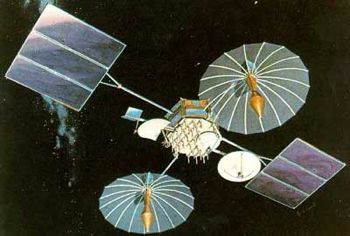 | TDRS 1 Credit: Manufacturer Image |
 | TDRS 7 Credit: Manufacturer Image |
 | STS-6 Deployment of the TDRS by STS-6 Challenger Credit: NASA |
 | STS-6 TDRS satellite over African Rift Valley, Kenya, Africa Credit: NASA |
 | STS-26 STS-26 Discovery, Orbiter Vehicle (OV) 103, IUS / TDRS-C deployment Credit: NASA |
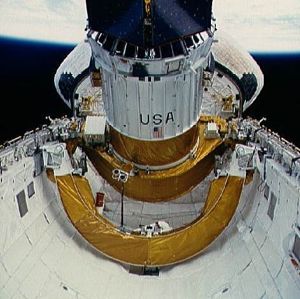 | STS-26 STS-26 Discovery, Orbiter Vehicle (OV) 103, IUS / TDRS-C deployment Credit: NASA |
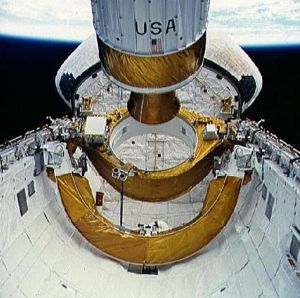 | STS-26 STS-26 Discovery, Orbiter Vehicle (OV) 103, IUS / TDRS-C deployment Credit: NASA |
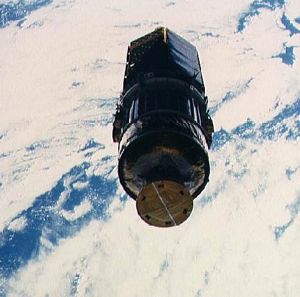 | STS-26 STS-26 Discovery, Orbiter Vehicle (OV) 103, IUS / TDRS-C deployment Credit: NASA |
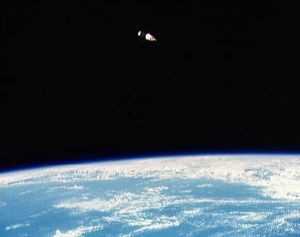 | STS-26 STS-26 Discovery, Orbiter Vehicle (OV) 103, IUS / TDRS-C deployment Credit: NASA |
 | STS-29 STS-29 IUS with TDRS-D drifts above Earth's surface during post deployment Credit: NASA |
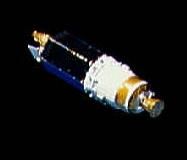 | STS-29 STS-29 IUS with TDRS-D after deployment from Discovery, OV-103 Credit: NASA |
1978 April 6 - . LV Family: Titan, Shuttle. Launch Vehicle: Titan 34D, Shuttle.
- Titan III 34D/IUS not to be used as backup for launch of a Tracking and Data Relay Satellite. - . Spacecraft: TDRS. NASA withdrew its requirement for a Titan III 34D/IUS to be used as backup for a space shuttle launch of a Tracking and Data Relay Satellite in 1980..
1983 April 4 - . 18:30 GMT - . Launch Site: Cape Canaveral. Launch Complex: Cape Canaveral LC39A. Launch Platform: MLP2. LV Family: Shuttle. Launch Vehicle: Space Shuttle.
- TDRS 1 - .
Payload: TDRS A. Mass: 2,268 kg (5,000 lb). Nation: USA.
Agency: NASA Greenbelt.
Program: STS.
Class: Communications.
Type: Civilian communications satellite. Spacecraft: TDRS.
USAF Sat Cat: 13969 . COSPAR: 1983-026B. Apogee: 35,976 km (22,354 mi). Perigee: 35,835 km (22,266 mi). Inclination: 7.40 deg. Period: 1,442.20 min.
Element of satellite communications network, deployed from STS-6 5 April 1983. Spacecraft engaged in practical applications and uses of space technology such as weather or communication (US Cat C). Positioned in geosynchronous orbit at 67 deg W in 1983; 41 deg W in 1983-1989; 79 deg W in 1989-1990; 170 deg W in 1990-1993; 85 deg E in 1994-1995; 49 deg W in 1996-on. As of 5 September 2001 located at 49.36 deg W drifting at 0.010 deg E per day. As of 2007 Mar 9 located at 48.98W drifting at 0.029W degrees per day.
1986 January 28 - . 16:38 GMT - . Launch Site: Cape Canaveral. Launch Complex: Cape Canaveral LC39B. Launch Platform: MLP2. LV Family: Shuttle. Launch Vehicle: Space Shuttle. FAILURE: Failure.
- TDRS B - . Payload: TDRS B. Mass: 2,240 kg (4,930 lb). Nation: USA. Agency: NASA. Program: STS. Class: Communications. Type: Civilian communications satellite. Spacecraft: TDRS. Apogee: 15 km (9 mi).
1988 September 29 - . 15:37 GMT - . Launch Site: Cape Canaveral. Launch Complex: Cape Canaveral LC39B. Launch Platform: MLP2. LV Family: Shuttle. Launch Vehicle: Space Shuttle.
- TDRS 3 - .
Payload: TDRS C. Mass: 2,200 kg (4,800 lb). Nation: USA.
Agency: NASA Greenbelt.
Program: STS.
Class: Communications.
Type: Civilian communications satellite. Spacecraft: TDRS.
USAF Sat Cat: 19548 . COSPAR: 1988-091B. Apogee: 35,796 km (22,242 mi). Perigee: 35,774 km (22,228 mi). Inclination: 0.50 deg. Period: 1,436.10 min.
NASA communications; 171 deg W; deployed from STS-26 . Spacecraft engaged in practical applications and uses of space technology such as weather or communication (US Cat C). Positioned in geosynchronous orbit at 151 deg W in 1988; 171 deg W in 1989-1990; 174 deg W in 1990-1991; 62 deg W in 1991-1994;171 deg W in 1994-1995; 85 deg E in 1995-1999 As of 26 August 2001 located at 85.17 deg E drifting at 0.007 deg E per day. As of 2007 Mar 10 located at 84.98E drifting at 0.004W degrees per day.
1989 March 13 - . 14:57 GMT - . Launch Site: Cape Canaveral. Launch Complex: Cape Canaveral LC39B. Launch Platform: MLP2. LV Family: Shuttle. Launch Vehicle: Space Shuttle.
- TDRS 4 - .
Payload: TDRS D. Mass: 2,120 kg (4,670 lb). Nation: USA.
Agency: NASA Greenbelt.
Program: STS.
Class: Communications.
Type: Civilian communications satellite. Spacecraft: TDRS.
USAF Sat Cat: 19883 . COSPAR: 1989-021B. Apogee: 35,803 km (22,246 mi). Perigee: 35,773 km (22,228 mi). Inclination: 4.60 deg. Period: 1,436.20 min.
Deployed from STS 29 13 March 1989; NASA communications; 41 deg W. Spacecraft engaged in practical applications and uses of space technology such as weather or communication (US Cat C). Positioned in geosynchronous orbit at 41 deg W in 1989-1999 As of 5 September 2001 located at 41.04 deg W drifting at 0.010 deg W per day. As of 2007 Mar 10 located at 45.81W drifting at 0.008W degrees per day.
1991 August 2 - . 15:02 GMT - . Launch Site: Cape Canaveral. Launch Complex: Cape Canaveral LC39A. Launch Platform: MLP1. LV Family: Shuttle. Launch Vehicle: Space Shuttle.
- TDRS 5 - .
Payload: TDRS E. Mass: 2,200 kg (4,800 lb). Nation: USA.
Agency: NASA Greenbelt.
Program: STS.
Class: Communications.
Type: Civilian communications satellite. Spacecraft: TDRS.
USAF Sat Cat: 21639 . COSPAR: 1991-054B. Apogee: 35,790 km (22,230 mi). Perigee: 35,783 km (22,234 mi). Inclination: 0.00 deg. Period: 1,436.10 min.
NASA communications; 174 deg W; deployed from STS-43 8/2/91. Spacecraft engaged in research and exploration of the upper atmosphere or outer space (US Cat B). Positioned in geosynchronous orbit at 174 deg W in 1991-1999 As of 1 September 2001 located at 174.28 deg W drifting at 0.011 deg E per day. As of 2007 Mar 10 located at 171.61W drifting at 0.006W degrees per day.
1993 January 13 - . 13:59 GMT - . Launch Site: Cape Canaveral. Launch Complex: Cape Canaveral LC39B. Launch Platform: MLP2. LV Family: Shuttle. Launch Vehicle: Space Shuttle.
- TDRS 6 - .
Payload: TDRS F. Mass: 2,530 kg (5,570 lb). Nation: USA.
Agency: NASA Greenbelt.
Program: STS.
Class: Communications.
Type: Civilian communications satellite. Spacecraft: TDRS.
USAF Sat Cat: 22314 . COSPAR: 1993-003B. Apogee: 35,792 km (22,240 mi). Perigee: 35,779 km (22,231 mi). Inclination: 0.70 deg. Period: 1,436.10 min.
NASA communications; deployed from STS-54 1/13/93. Spacecraft engaged in research and exploration of the upper atmosphere or outer space (US Cat B). Positioned in geosynchronous orbit at 150 deg W in 1993; 138 deg W in 1993; 46 deg W in 1994-1999 As of 5 September 2001 located at 46.99 deg W drifting at 0.017 deg W per day. As of 2007 Mar 8 located at 173.51W drifting at 0.006E degrees per day.
1995 July 13 - . 13:41 GMT - . Launch Site: Cape Canaveral. Launch Complex: Cape Canaveral LC39B. Launch Platform: MLP2. LV Family: Shuttle. Launch Vehicle: Space Shuttle.
- TDRS 7 - .
Payload: TDRS G. Mass: 2,120 kg (4,670 lb). Nation: USA.
Agency: NASA Greenbelt.
Program: STS.
Class: Communications.
Type: Civilian communications satellite. Spacecraft: TDRS.
USAF Sat Cat: 23613 . COSPAR: 1995-035B. Apogee: 35,797 km (22,243 mi). Perigee: 35,776 km (22,230 mi). Inclination: 5.30 deg. Period: 1,436.10 min.
NASA communications; deployed from STS-70 on 7/13/95. Stationed at 149.8 deg W. Positioned in geosynchronous orbit at 150 deg W in 1995-1996; 171 deg W in 1996-1999 As of 3 September 2001 located at 171.48 deg W drifting at 0.017 deg W per day. As of 2007 Mar 11 located at 150.85W drifting at 0.002E degrees per day.
Back to top of page
Home - Search - Browse - Alphabetic Index: 0- 1- 2- 3- 4- 5- 6- 7- 8- 9
A- B- C- D- E- F- G- H- I- J- K- L- M- N- O- P- Q- R- S- T- U- V- W- X- Y- Z
© 1997-2019 Mark Wade - Contact
© / Conditions for Use